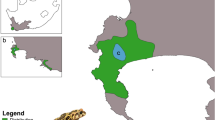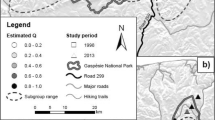Abstract
Edge and central populations can show great differences regarding their genetic variation and thereby also in their probability of extinction. This fact might be of great importance for the conservation strategies of endangered species. In this study we examine the level of microsatellite variability within three threatened edge populations of the green lizard subspecies Lacerta viridis viridis (Laur.) in Brandenburg (Germany) and compare the observed variation to other edge and central populations within the northern species range. We demonstrate that the northernmost edge populations contain less genetic variation in comparison to the central population. However, there were no observable significant differences to the other edge population included in this study. Surprisingly, we observed a high genetic differentiation in a small geographical range between the three endangered populations in Brandenburg, which can be explained by processes like fragmentation, isolation, genetic drift and small individual numbers within these populations. We also detected unique genetic variants (alleles), which only occurred in these populations, despite a low overall genetic variation. This study demonstrates the potential of fast evolving markers assessing the genetic status of endangered populations with a high resolution. It also illustrates the need for a comparative analysis of different regions within the species range, achieving a more exact interpretation of the genetic variation in endangered populations. This will aid future management decisions in the conservation of genetic diversity in threatened species.

Similar content being viewed by others
References
Amos W, Balmford A (2001) When does conservation genetics matter? Heredity 87:257–265
Avise JC (1994) Molecular markers, natural history and evolution. Chapman & Hall, New York
Balloux F, Lugon-Moulin N (2002) The estimation of population differentiation with microsatellite markers. Mol Ecol 11:155–165
Böhme MU, Berendonk TU, Schlegel M (2005) Isolation of new microsatellite loci from the Green Lizard (Lacerta viridis viridis). Mol Ecol Notes 5:45–47
Cornuet JM, Luikart G (1996) Description and power analysis of two tests for detecting recent population bottlenecks from allele frequency data. Genetics 144:2001–2014
DeSalle R, Amato G (2004) The expansion of conservation genetics. Nat Rev Genet 5:702–712
Edenhamn P, Hoggren M, Carlson A (2000) Genetic diversity and fitness in peripheral and central populations of the European tree frog Hyla arborea. Hereditas 133:115–122
Elbing K (2000) Fortpflanzungsbiologie und Populationsökologie der Smaragdeidechse (Lacerta viridis, Laurenti, 1768) in ihren brandenburgischen Reliktvorkommen. PhD thesis, Universität Bremen, Germany
Elbing K (2001a) Die Smaragdeidechsen-zwei (un)gleiche Schwestern. Laurenti Verlag, Bochum
Elbing K (2001b) Das Artenschutzprogramm “Smaragdeidechse” Lacerta viridis (Laurenti, 1768) des Landes Brandenburg. Mertensiella 13:269–278
Excoffier L, Smouse PE, Quattro JM (1992) Analysis of molecular variance inferred from metric distances among DNA haplotypes: application to human mitochondrial DNA restriction data. Genetics 131:479–491
Favre L, Balloux F, Goudet J, Perrin N (1997) Female-biased dispersal in the monogamous mammal Crocidura russula: evidence from field data and microsatellite patterns. Proc R Soc B 264:127–132
Frankham R (1995) Inbreeding and extinction: island populations. Conserv Biol 12:665–675
Garza JC, Williamson EG (2001) Detection of reduction in population size using data from microsatellite loci. Mol Ecol 10:305–318
Goudet J (1995) Fstat (version 1.2): a computer program to calculate Fstatistics. Journal of Heredity 86:485–486 Version 2.9.3 available from http://www.unil.ch/izea/softwares/fstat.html [accessed March 2005]
Goudet J, Perrin N, Waser P (2002) Tests for sex-biased dispersal using bi-parentally inherited genetic markers. Mol Ecol 11:1103–1114
Gullberg A, Tegelstrom H, Olsson M (1997) Microsatellites in the sand lizard (Lacerta agilis): description, variation, inheritance, and applicability. Biochem Genet 35:281–295
Hartl DL, Clark GC (1997) Principles of population genetics, 3rd edn. Sinauer Associates, Sunderland, MA
Hecht G (1930) Die märkische Smaragdeidechse, Lacerta viridis (Laur.) subspec. brandenburgensis subspec. nov. Das Aquarium 1930:62
Hewitt GM (2001) Speciation, hybrid zones and phylogeography – or seeing genes in space and time. Mol Ecol 10:537–549
Hofman AA, Blows MW (1994) Species borders: ecological and evolutionary perspectives. Trends Ecol Evol 9:223–227
Kalinowski ST (2005) HP-RARE 1.0: a computer program for performing rarefaction on measures of allelic richness. Mol Ecol Notes 5:187–189
Keller LF, Waller DM (2002) Inbreeding effects in wild populations. Trends Ecol Evol 17(5):230–241
Kimura M, Crow JF (1964) The number of alleles that can be maintained in a finite population. Genetics 49:725–738
Kirmse W (1990) Die Smaragdeidechse in Brandenburg: Bestand und Schutzmaßnahmen. Die Eidechse 1:10–12
Kirmse W (1994) Zur aktuellen Situation der brandenburgischen Smaragdeidechse (Lacerta v. viridis). Die Eidechse 5:2–4
Lammi A, Siikamaki P, Mustajarvi K (1999) Genetic diversity, population size, and fitness in central and peripheral populations of a rare plant Lychnis viscaria. Conserv Biol 13:1069–1078
Lande R (1988) Genetics and demography in biological conservation. Science 241:1455–1460
Le Galliard JF, Ferriere R, Clobert J (2005) Effect of patch occupancy on immigration in the common lizard. J Anim Ecol 74:241–249
Lesica P, Allendorf FW (1995) When are peripheral populations valuable for conservation? Conserv Biol 9:753–760
Mertens R, Schnurre O (1946) Zur Eidonomie, Taxonomie und Ökologie der norddeutschen Smaragdeidechse. Senkenbergia 27:25–52
Mertens R, Schnurre O (1949) Eidonomische und ökologische Studien an Smaragdeidechsen Deutschlands. Abh Senckenb Nat Gesell 481:1–28
Moritz C (1999) Conservation units and translocations: strategies for conserving evolutionary processes. Hereditas 130:217–228
Nei M (1987) Molecular Evolutionary Genetics. Columbia University Press, New York
Peakall R, Smouse PE (2006) GENALEX 6: Genetic Analysis in Excel. Population genetic software for teaching and research. Mol Ecol Notes 6:288–295
Peters G (1970) Studien zur Taxonomie, Verbreitung und Ökologie der Smaradeidechsen IV. Zur Ökologie und Geschichte der Populationen von Lacerta v. viridis (Laurenti) im mitteleuropäischen Flachland. Veröff Bez Mus Potsdam 21:49–119
Petrosyan VG, Tokarskaya ON, Malysheva DN, Ryskov AP (2003) Quantitative assessment of gene diversity and between—population differentiation of parthenogenetic lizard of the genus Darevskia using Mini- and Microsatellite DNA markers. Russ J Gen 39:1201–1207
Pinho C, Sequeira F, Godinho R, Harris DJ, Ferrand N (2004) Isolation and characterization of nine microsatellite loci in Podarcis bocagei (Squamata: Lacertidae). Mol Ecol Notes 4:286–288
Pritchard JK, Stephens M, Donnelly P (2000) Inference of population structure using multilocus genotype data. Genetics 155:945–959
Raymond M, Rousset F (1995) Genepop (version1.2): population genetics software for exact tests and ecumenicism. J Hered 86:248–249
Ryberg K, Olsson M, Wapstra E, Madsen T, Anderholm S, Ujvari B (2004) Offspring-driven local dispersal in female sand lizards (Lacerta agilis). J Evol Biol 17:1215–1220
Schneeweiß N (2001) Aspekte der Entwicklung und des Ausbreitungsverhaltens von Smaragdeidechsen (Lacerta viridis viridis) in einem Ansiedlungsversuch in Brandenburg. Mertensiella 13:229–240
Schneeweiß N, Krone A, Baier R (2004) Rote Listen und Artenlisten der Lurche (Amphibia) und Kriechtiere (Reptilia) des Landes Brandenburg. Natur Landschaftspfl Brand 13(4):35S
Spencer CC, Neigel JE, Leberg PL (2000) Experimental evaluation of the usefulness of microsatellite DNA for detecting demographic bottlenecks. Mol Ecol 9:1517–1528
Acknowledgements
We are very grateful to M. Stein for his extraordinary help and cooperation in the field. We thank the Naturschutzstation Rhinluch (Landesumweltamt Brandenburg) for the cooperation within the project and for the help with the required permit. We also thank the ministry of Agriculture, Environmental protection and Regional planning for the permit to study the endangered population in Brandenburg. Furthermore we thank J. Moravec and J. Vörös for their help regarding the Czech and Hungarian samples. We thank K. Lampert and the two anonymous reviewers for the helpful comments on the manuscript and A.D. Sommerfeldt for improving the language of a previous draft. This study was supported by the Heinz Sielmann Stiftung and the work of Manja Böhme was supported by the Evangelische Studienwerk Villigst e.V.
Author information
Authors and Affiliations
Corresponding author
Rights and permissions
About this article
Cite this article
Böhme, M.U., Schneeweiß, N., Fritz, U. et al. Small edge populations at risk: genetic diversity of the green lizard (Lacerta viridis viridis) in Germany and implications for conservation management. Conserv Genet 8, 555–563 (2007). https://doi.org/10.1007/s10592-006-9191-0
Received:
Accepted:
Published:
Issue Date:
DOI: https://doi.org/10.1007/s10592-006-9191-0




